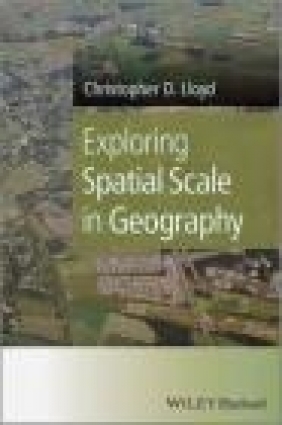Exploring Spatial Scale
Christopher D. Lloyd
Exploring Spatial Scale
Christopher D. Lloyd
- Producent: John Wiley
- Rok produkcji: 2014
- ISBN: 9781119971351
- Ilość stron: 272
- Oprawa: Twarda
Niedostępna
Opis: Exploring Spatial Scale - Christopher D. Lloyd
Exploring Spatial Scale in Geography provides a conceptual and practical guide to issues of spatial scale in all areas of the physical and social sciences. Scale is at the heart of geography and other spatial sciences. Whether dealing with geomorphological processes, population movements or meteorology, a consideration of spatial scale is vital. Exploring Spatial Scale in Geography takes a practical approach with a core focus on real world problems and potential solutions. Links are made to appropriate software environments with an associated website providing access to guidance material which outlines how particular problems can be approached using popular GIS and spatial data analysis software. This book offers alternative definitions of spatial scale, presents approaches for exploring spatial scale and makes use of a wide variety of case studies in the physical and social sciences to demonstrate key concepts, making it a key resource for anyone who makes use of geographical information.Preface xiii Acknowledgements xv About the Companion Website xvii 1 Introduction 1 1.1 The purpose of the book 1 1.1.1 What this book adds 3 1.1.2 Scales of analysis and alternative definitions 3 1.2 Key objectives 4 1.3 Case studies and examples 5 1.4 Why is spatial scale important? 5 1.5 Structure of the book 6 1.6 Further reading 6 References 7 2 Scale in Spatial Data Analysis: Key Concepts 9 2.1 Definitions of spatial scale 9 2.2 Spatial autocorrelation and spatial dependence 11 2.3 Scale dependence 13 2.4 Scale and data models 14 2.5 Spatial scales of inquiry 14 2.6 Scale and spatial data analysis 14 2.7 Scale and neighbourhoods 15 2.8 Scale and space 16 2.9 Scale, spatial data analysis and physical processes 23 2.10 Scale, spatial data analysis and social processes 25 2.11 Summary 26 2.12 Further reading 26 References 26 3 The Modifiable Areal Unit Problem 29 3.1 Basic concepts 29 3.2 Scale and zonation effects 29 3.3 The ecological fallacy 32 3.4 The MAUP and univariate statistics 34 3.4.1 Case study: segregation in Northern Ireland 35 3.4.2 Spatial approaches to segregation 38 3.5 Geographical weighting and the MAUP 38 3.6 The MAUP and multivariate statistics 39 3.6.1 Case study: population variables in Northern Ireland 40 3.7 Zone design 41 3.8 Summary 42 3.9 Further reading 42 References 42 4 Measuring Spatial Structure 45 4.1 Basic concepts 45 4.2 Measures of spatial autocorrelation 45 4.2.1 Neighbourhood size 47 4.2.2 Spatial autocorrelation and kernel size 47 4.2.3 Spatial autocorrelation and lags 50 4.2.4 Local measures 50 4.2.5 Global and local I and spatial scale 51 4.3 Geostatistics and characterising spatial structure 53 4.3.1 The theory of regionalised variables 54 4.4 The variogram 57 4.4.1 Bias in variogram estimation 59 4.5 The covariance function and correlogram 59 4.6 Alternative measures of spatial structure 60 4.7 Measuring dependence between variables 63 4.8 Variograms of risk 64 4.9 Variogram clouds and h-scatterplots 64 4.10 Variogram models 65 4.11 Fitting variogram models 68 4.12 Variogram case study 70 4.13 Anisotropy and variograms 74 4.13.1 Variogram surfaces 74 4.13.2 Geometric and zonal anisotropy 75 4.14 Variograms and non-stationarity 77 4.14.1 Variograms and long-range trends 77 4.14.2 Variogram non-stationarity 79 4.15 Space--time variograms 82 4.16 Software 83 4.17 Other methods 83 4.18 Point pattern analysis 84 4.18.1 Spatial dependence and point patterns 85 4.18.2 Local K function 91 4.18.3 Cross K function 92 4.19 Summary 97 4.20 Further reading 97 References 97 5 Scale and Multivariate Data 103 5.1 Regression frameworks 104 5.2 Spatial scale and regression 104 5.3 Global regression 105 5.4 Spatial regression 105 5.5 Regression and spatial data 106 5.5.1 Generalised least squares 106 5.5.2 Spatial autoregressive models 107 5.5.3 Spatially lagged dependent variable models and spatial error models case study 109 5.6 Local regression and spatial scale 111 5.6.1 Spatial expansion method 111 5.6.2 Geographically weighted regression 112 5.6.3 Scale and GWR 115 5.6.4 GWR case study: fixed bandwidths 115 5.6.5 GWR case study: variable bandwidths 116 5.6.6 Bayesian spatially varying coefficient process models 118 5.7 Multilevel modelling 119 5.7.1 Case study 125 5.8 Spatial structure of multiple variables 129 5.9 Multivariate analysis and spatial scale 130 5.10 Summary 131 5.11 Further reading 131 References 131 6 Fractal Analysis 135 6.1 Basic concepts 135 6.2 Measuring fractal dimension 138 6.2.1 Walking-divider method 139 6.2.2 Box-counting method 140 6.2.3 Variogram method 142 6.3 Fractals and spatial structure 142 6.3.1 Case study: fractal D of land surfaces 143 6.3.2 Case study: local fractal D 146 6.3.3 Fractals and topographic form 149 6.4 Other applications of fractal analysis 152 6.4.1 Fractals and remotely sensed imagery 152 6.4.2 Fractals and urban form 153 6.5 How useful is the fractal model in geography? 155 6.6 Summary 155 6.7 Further reading 155 References 155 7 Scale and Gridded Data: Fourier and Wavelet Transforms 159 7.1 Basic concepts 159 7.2 Fourier transforms 160 7.2.1 Continuous Fourier transform 160 7.2.2 Discrete Fourier transform 161 7.2.3 Fast Fourier transform 163 7.2.4 FFT case study 163 7.2.5 Spectral analysis and the covariance function 165 7.2.6 Spectral analysis case study 167 7.3 Wavelet transforms 168 7.3.1 Continuous wavelet transforms 169 7.3.2 Discrete wavelet transforms 170 7.3.3 The Haar basis functions 171 7.3.4 Other basis functions 172 7.3.5 Fast wavelet transform 173 7.3.6 Two-dimensional wavelet transforms 174 7.4 Wavelet analysis applications and other issues 180 7.5 Summary 180 7.6 Further reading 180 References 181 8 Areal Interpolation 183 8.1 Basic concepts 183 8.2 Areal weighting 184 8.3 Using additional data 186 8.3.1 Types of secondary data sources for mapping populations 192 8.4 Surface modelling 193 8.4.1 Population surface case study 195 8.5 Other approaches to changing support 196 8.6 Summary 197 8.7 Further reading 198 References 198 9 Geostatistical Interpolation and Change of Support 201 9.1 Basic concepts 201 9.2 Regularisation 201 9.2.1 Regularisation with an irregular support 204 9.3 Variogram deconvolution 205 9.3.1 Variogram deconvolution for irregular supports 206 9.3.2 Variography and change of support 208 9.4 Kriging 210 9.4.1 Punctual kriging 210 9.4.2 Poisson kriging 212 9.4.3 Factorial kriging 213 9.4.4 Factorial kriging case study 215 9.4.5 Kriging in the presence of a trend 215 9.4.6 Cokriging 222 9.4.7 Kriging with an external drift and other techniques 222 9.4.8 Interpreting the kriging variance 223 9.4.9 Cross-validation 223 9.4.10 Conditional simulation 224 9.4.11 Comparison of kriging approaches 224 9.5 Kriging and change of support 226 9.5.1 Block kriging 226 9.5.2 Area-to-point kriging 227 9.5.3 Case study 229 9.6 Assessing uncertainty and optimal sampling design 231 9.6.1 Nested sampling 231 9.6.2 Assessing optimal sampling design 232 9.6.3 Optimal spatial resolution 235 9.6.4 Other approaches to optimal sampling design 236 9.7 Summary 236 9.8 Further reading 236 References 236 10 Summary and Conclusions 241 10.1 Overview of key concepts and methods 241 10.2 Problems and future directions 243 10.3 Summary 245 References 245 Index 247
Szczegóły: Exploring Spatial Scale - Christopher D. Lloyd
Tytuł: Exploring Spatial Scale
Autor: Christopher D. Lloyd
Producent: John Wiley
ISBN: 9781119971351
Rok produkcji: 2014
Ilość stron: 272
Oprawa: Twarda
Waga: 0.58 kg




















